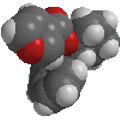Useful Concepts |
Useful Concepts |
Key Issues :
In the early stages of learning to use curly arrows it may be helpful to use Lewis structures to help you see those all important electrons. Note that the mechanisms throughout this website are drawn showing lone pairs, especially those on oxygen and nitrogen because they are important.
| STUDY TIP : It's a good idea to get into the habit of showing the lone pairs (especially on C, N and O atoms) Why ? Because they will often give an insight into the reactions of these important atoms. |
 |
© Dr. Ian Hunt, Department of Chemistry, University of Calgary |  |